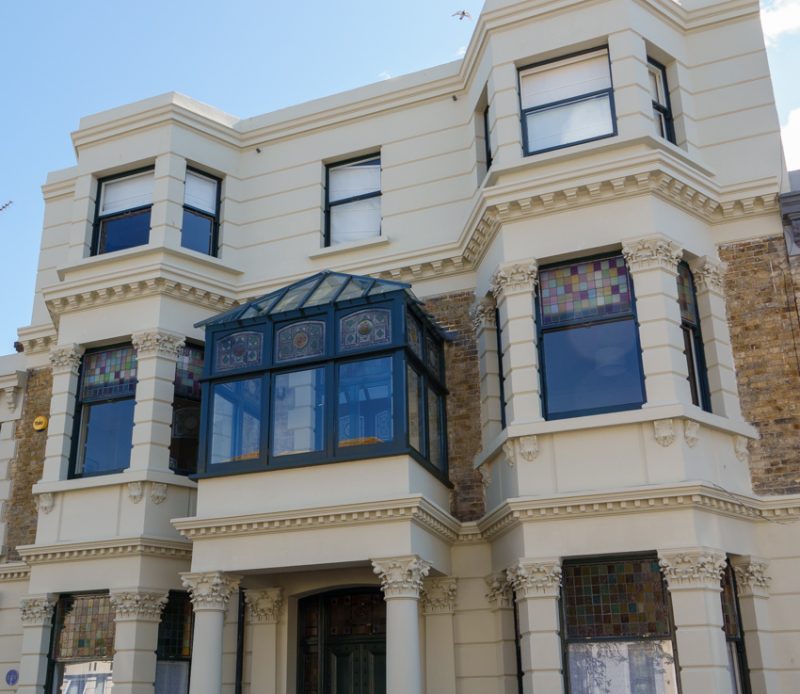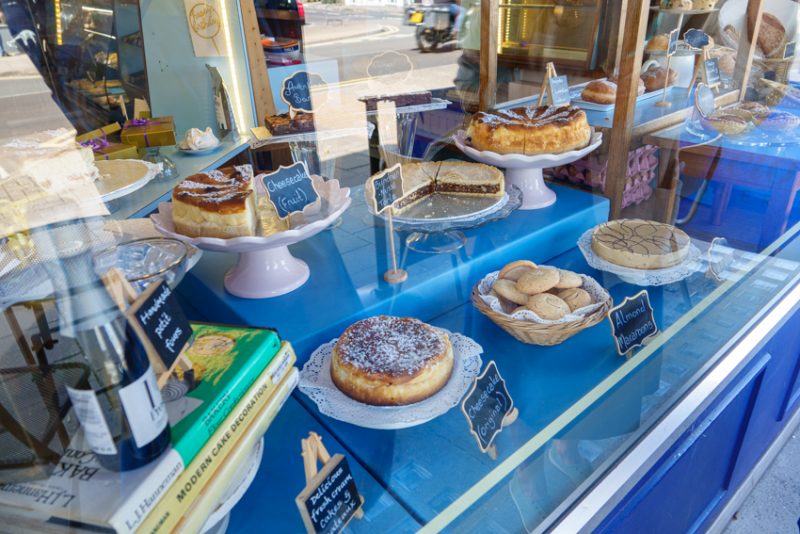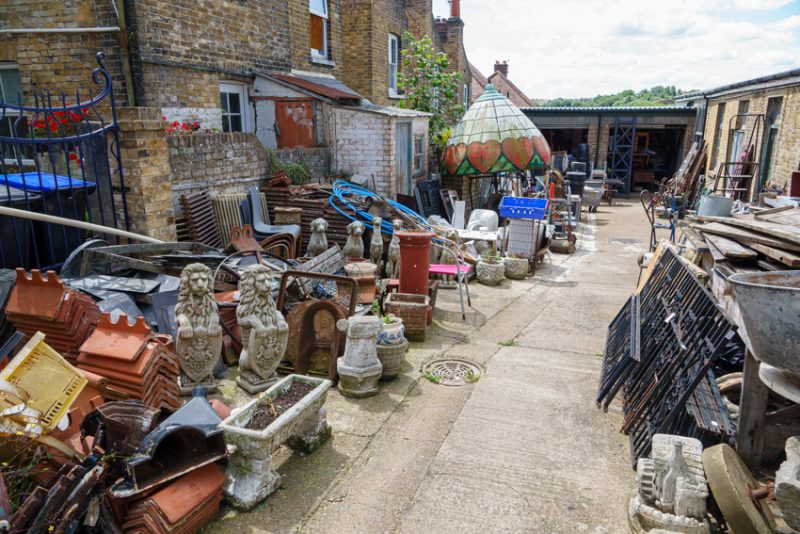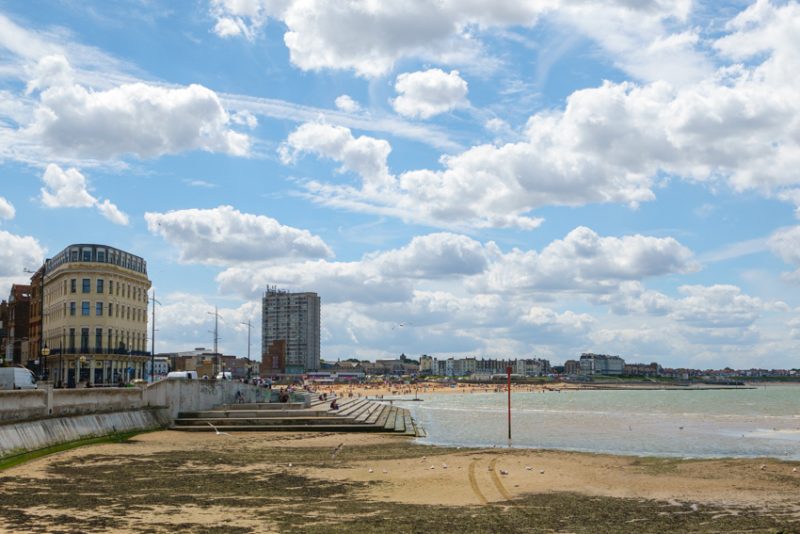Words Amicia de Moubray, Lisa Valder, Posy Gentles Photographs Lisa Valder

Faversham Life loses its shirt at the arcades in Margate
Faversham Life took the train to Margate. Twenty-eight minutes later, we alighted at the fine station, built in a monumental classical style, with a high semi-cylindrical vault complete with a Diocletian window, in 1926 by Edwin Maxwell Fry, who went on to work with Gropius and Le Corbusier. We came out into brilliant sunshine and a fresh sea breeze. To our right, we saw brutalist Arlington Tower soaring into the blue sky, the Dreamland tower, and beyond, its ferris wheel. Ahead of us, we saw the glittering sea and the handsome Edwardian promenade shelter where TS Eliot wrote the first draft of The Wasteland.

Faversham Life alights at Margate station

The rediscovered beauty of Arlington Tower and Dreamland
If this is all sounding rather highfalutin, it is in an attempt to dispel preconceived notions of Margate which all have a good deal of truth but taken separately tend to diminish and caricature this Thanet town. It is seen as a town with a violent past (Mods and Rockers), and present (no-go areas and drugs); Shoreditch-on-Sea, a hipster resort; Tracy Emin’s art project; a town which has lost its identity to the developers; a rundown, hasbeen of a town which lost its livelihood to budget flights and the accessibility of scorching costas and rivieras. Covid 19 has denied us these delights in the past year and a half and we are rediscovering the joys of the British resort. Faversham Life found Margate offered much more than beer and sunburn (although it does offer that), and much more than a town regenerated for monied Londoners (although it offers that too). We were vastly amused all day and we didn’t even go to The Turner or swim!

With the colourfully painted houses, you could mistake this for Tenby, but it is Kent’s own lovely Margate
As we left the station, evidently looking just like the tourists we were, a kindly man stopped and asked us if we needed directions. We explained our mission and Keith Barbara, for that was his name, was able to give us many memories of Margate in the 1950s and 1960s. He remembered shrimping on the sands and finding seahorses in his net, and the old coal boats in the harbour which serviced the gasworks in the Old Town. He told us of the steamers packed with holidaymakers which came down from Tower Bridge. They were dropped at a pier (which no longer exists), and others would embark for a day trip to France. In the 1960s, there were so many people visiting Margate that the trains were much longer than the platform, and passengers had to disembark in stages as the train shuffled forward.

A view to the harbour arm
Lisa Valder, Faversham Life’s photographer, has recently moved to Margate, and took us first on a tour of Cliftonville, which is situated to the east, and up the hill from the main town. Lisa says: ‘In the first half of the 20th century, Cliftonville was a thriving holiday resort. It was considered the upmarket alternative to Margate, with its many hotels and guesthouses. But in the latter part of the century, it went into decline.

Northdown Rd in Cliftonville

Fine architectural features in neglected shopfronts

This renovated Cliftonville shop has an independent air

A marvellously restored Edwardian house
In Northdown Road, we had an excellent late breakfast with locally-roasted Curve coffee, in Cliffs a café which also encompasses a hairdressers and vinyl shop.

Breakfast at Cliffs

Vinyl and hairdos
Food became a theme to our wanderings. We succumbed to delicious gluten-free cakes and paraben-free soaps in The Grain Grocer, a wholefood shop, and discovered Batchelor’s, a traditional patisserie with gypsy tart and baked cheesecake.

Whole foods galore and a sleeping greyhound

A Cliftonville patisserie

Traditional and delectable
There are two excellent wide-ranging international food shops – Nasza Biedronka catering to Eastern European tastes, where we found ranks of jarred pickles, piles of fresh vegetables and a fine range of cured meats; and the recently-expanded International Food Centre where we found a whole shelf devoted to different types and brands of tahini, stacks of huge tins of olive oil and much more besides.

Mete Yildirim and his son, who with his brother, has expanded the International Food Centre

Heaps of fresh vegetables among fridges of cured meats and shelves of pickles in Nasza Biedronka
Sadly unable to squeeze in another breakfast, we could only admire the eggs, bacon, sausages and mugs of tea being served up at Dalby’s in Cliftonville.

Dalby’s

The rapt attention of a dog when his owner is eating breakfast
Cliftonville is the home of Scott’s Antiques – a sprawling shop crammed into a huge old Ice Factory. The joy of Scott’s is its lack of curation. Although items are divided by subject – chairs, plates, door knobs, lamps – there is no attempt to separate era or style, the extraordinary and the mundane. Consequently, there is the joy of discovery. If inclined, you could easily spend the whole day there.

Scott’s of Margate

The yard at Scott’s
Just down the hill from Scott’s is the mysterious and beautiful Shell Grotto but, running out of time, we decided to visit Margate Caves instead.
Originally hand dug as a chalk quarry, probably in the 17th century, they are 94.2m long and 12.2m tall at the highest point. First opened to visitors in 1863 when they were called Vortigern’s Cavern, they proved a popular tourist attraction. In 2004, they were closed for health and safety reasons but reopened in 2019 with a smart new museum designed by the Kent architects, Kaner Olette. Once again it is possible to descend into the chalk bowls of Thanet and marvel at the cathedral-like spaces. Curiously, the walls of the main chamber are painted with eccentric depictions of the Thanet Hunt along with other such oddities as a large crocodile.

The high vaulted chalk caves, rather surprisingly, feature paintings of hunting scenes
Past the blue plaque showing where John Le Measurier and Hattie Jaques lived, we descended into Margate’s Old Town and sank onto a bench under another blue plaque commemorating Karl Marx’s visit to Margate, opposite the pub where Eric Morecambe had his wedding reception, to eat a coffee, walnut and fudge ice cream from Ramsay & Williams.

A day at the seaside is incomplete without an ice cream
Along with galleries and antique shops, the Old Town has excellent restaurants such as Angela’s which specialises in fish, and Michelin-starred Bottega Caruso. The smell of Southern Italian cooking wafts from its doorway. The pastas are freshly made every day and many of the ingredients are sourced from the owner’s family and friends in her native Campania. There are also marvellous cafés. We lunched at The Greedy Cow located in the heart of the old town, and ate huge toasties with oozing melting cheese.

Painted shopfronts in the Old Town

Shopping for vintage items

Found in the bookshop
From the Old Town, we walked on along the sea front, towards Dreamland, where we stopped off to win fortunes in the arcades, and look out over the sea.

The Front

Neon beach balls and fishing nets and rock

The famous golden Margate sands
As we perambulated, Amicia, something of an expert on Thanet architecture having edited the SAVE Britain’s Heritage book Saving Thanet – The Architecture of Kent’s Forgotten Coast, pointed out interesting architectural features.

The Theatre Royal, one of the earliest Georgian theatres built 1786-7.
She says: ‘Architectural buffs will find much to delight in Margate. Thanet boasts 2,500 listed buildings – the highest density of any district in Kent. In the 10 years since I edited Saving Thanet for SAVE Britain’s Heritage, the picture has changed immeasurably. All over Margate, and indeed Thanet, there is ample evidence of buildings being restored. But it is not all rosy – there remain scores of buildings gently slumbering waiting to be rescued.

The Art Deco beacon
‘The 1920s jaunty red four-sided Art Deco beacon proclaiming the Lido, is a chic reminder of the resort’s popularity at the beginning of the 20th century. Most intriguingly, it sits atop the remnants of the early 19th century Clifton Baths, one of the earliest sea bathing establishments in the country. There are currently plans to resurrect the Lido site. Watch this spot!’

Arlington Tower in the distance
Faversham Life had a marvellous day out and was back in time for tea. Margate’s nightlife must be for another time.
Text: Amicia, Lisa, Posy. Photographs: Lisa